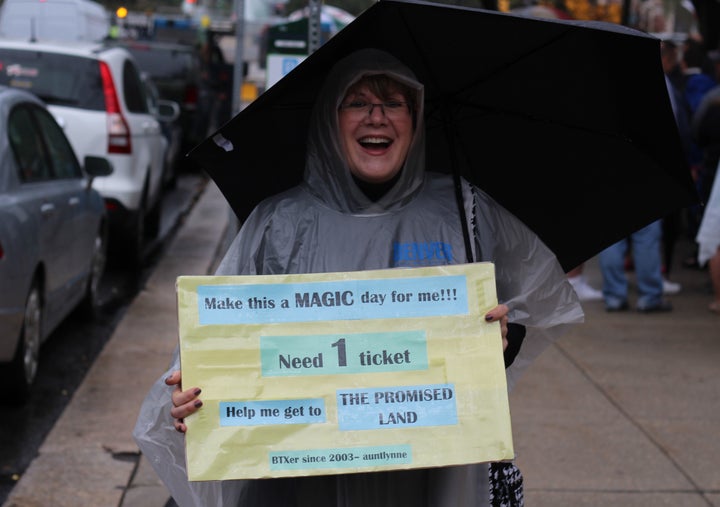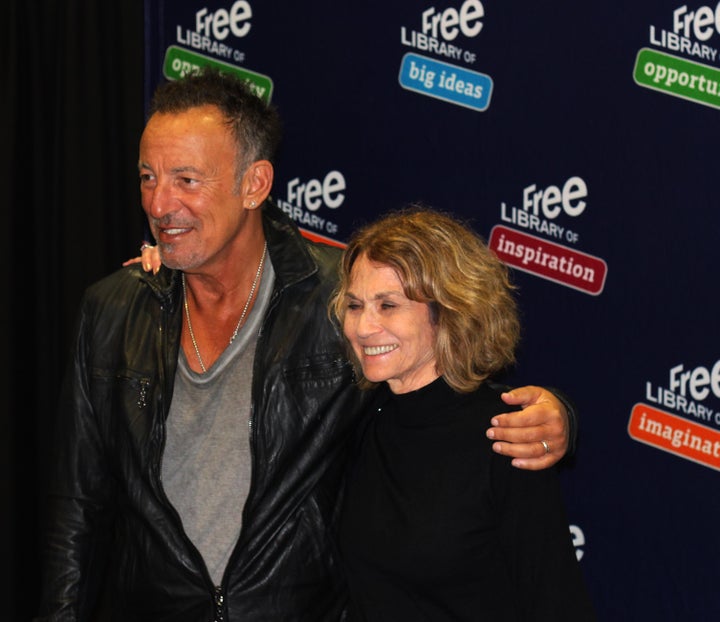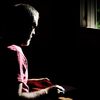


As the misty rain fell, the line of pilgrims stretched down Vine Street, up 19th, wrapped around Callowhill, and started back down 20th. It was still several hours prior to Bruce Springsteen’s scheduled arrival to the Philadelphia Free Library yesterday. Theirs were faces of the white upper-middle working class, in their 40s, 50s, 60s, some north. Most were from Philly, or the suburbs or Jersey, but some had flown in from Florida or the West Coast, and even a few from Europe just for the afternoon. Maybe a 60-40 women-to-men split, dressed in vintage concert t-shirts, jean jackets and leather, smiling under their umbrellas.
All seemed ready to burst from their skin.
Most had stories of dozens of shows they’d seen, everyone had vivid memories of their first. When you asked them simple questions, invariably they would mist up themselves. Occasionally, you’d catch someone silently mouthing rehearsals of a prepared speech.
On this third stop of Bruce Springsteen’s short book tour for his new autobiography Born to Run, the 1200 allotted tickets were gone even quicker than to one of his concerts. There would be no book reading or talk, this was purely Springsteen pressing the flesh. For their $33, each was guaranteed a moment with their hero, a quick word, a treasured selfie, a signed book. Word was the event sold out in under ten minutes, but the library reported that it was “closer to instantaneous, actually.”
Released on Tuesday, Springsteen’s 500-page autobiography gives him room to stretch out his dramatic stage tales, fill in the context, set the scene, deliver the story fully; it’s remarkably consistent.
The mythos of Springsteen has been well established from those stage stories: the early battles with his difficult father and his hard-won emergence from the “swamps of Jersey” into an international rock phenomenon. So you might expect more variance, more distant coolness in the chronological unfolding. But as a whole, it’s a good bit like his famous marathon live shows. And it’s surprising how often you get those soaring peaks, how readily it reads like the emotional experience of his music.
Many of the early reviews have focused on his revelation of the valleys, however. Springsteen spends a good portion of the book re-exploring the depression that he’s been treated for and has continued to struggle with over the past 30 years.
It’s clear-eyed. There are several passages spent explaining his reasons for mostly staying away from booze and drugs, an act of restraint so incongruent with his vocation. “I was always proud but also embarrassed by being so in control,” Springsteen acknowledges.
That control is also what has driven his success, and the longevity and reliable excellence of his E Street Band. When he says “We are more than an idea, an aesthetic. We are a philosophy, a collective, with a professional code of honor,” he says it without a hint of irony. “It is based on the principle that we bring our best, everything we have, on this night, to remind you of everything you have, your best.”
He’s more brash than you’d expect, but like the music, he’s most intriguing when he’s most unsure.
At the center of the book is the most fascinating chapter, an interior monologue of his first European visit, a highly anticipated London show in 1975 at the Hammersmith Odeon. He’s talked about it before, most notably a decade ago with the show’s DVD release, but the depth of his self-flagellation and ethos is most acutely felt here.
The chapter serves as the executive summary of the book, as he best explains his raison d’etre: “You’ve got to let the audience feel they’re coolly within your hands. That’s how you help them feel safe and free enough to let themselves go, to find whatever they’ve come looking for and be whoever they’ve come to be.” Everything that Springsteen makes himself out to be in Born to Run: manic, controlling, exuberant, unsure, and mostly, driven, is spelled out in the retelling.
The Driven
Sandra Kolber sat wide-smiled in Starbucks surrounded by her family, having just walked away from her Springsteen hug: “I just loved seeing his face. So generous. And I was rehearsed—I usually don’t give my age, but I just had a big one. So I told him, “I just turned 80 and I’ve been seeing you since 1978.’ He said ‘you’re a doll,’ and I got to give him a kiss. So just a couple of seconds, but I made it work. I made it work.”
Like his work, the book is specked with moments of wide-eyed joy and moments of squinting-back-the tears sadness. That ebb and flow has been what’s drawn millions who see a better vision of themselves in him. The memoir does nothing but confirm what we’ve always thought: see, he’s going through it too.
Having spent the better part of my life among them—as one of them—they are a serious lot: quick to temper, fast to love, easy to laugh, pre-disposed to cry. And most share with their idol that running engine of “I could be more . . .”
The Grateful
Sandy Horrocks, The Free Library’s VP of External Affairs, hasn’t seen hundreds of shows, but was an enthusiastic fan around this visit: “I am so pleased that he chose us as the only library on this book tour.” When pressed on the decision to keep ticket prices low when they easily could have brought much higher prices, Horrocks flatly and beautifully said “We’re a public library, and our mission is to serve all.”
Lynne Byck was there early, ticketless, smiling, looking for a miracle: “I first saw him at The Spectrum, many years ago, but the thing I remember most is he was collecting cans for food banks. And it really resonated with me, which is what I want to tell him if I get a chance. Since then, I’ve really, really tried to do good, be benevolent. To give, to be a good person. It was somebody other than my parents who said you need to give of yourself, and I idolized him. He’s just the real deal.”
Moments later, a fan with an extra made Byck’s day, and they dissolved into a teary sidewalk embrace.
Sometime between the release of 1982’s Nebraska record and 1984’s mega-smash Born in the USA, Springsteen’s simmering depression began to boil over. Though the childhood and early career chapters are interesting and well-written, it’s in a re-telling of a cross country trip where he was t-boned by his depression, that he fully engages himself as a writer. The rest of the book takes on a less mythic, more confessional tone. “All I do know is as we age the weight of our unsorted baggage becomes heavier . . . much heavier,” he writes.
Most poignant are the chapters on his father and particularly his father's death, unsurprising given the narratives about their relationship he’s told onstage for the last 40 years.
What becomes apparent in the reading is that Springsteen has always been his best at writing elegies. And as is Springsteen’s genius as a songwriter, those chapters put you in the protagonist seat, trying to hold the darkness at bay. In the music, it’s often a golden lament for a memory. Here, it’s for the people of his life.
His father, his grandmother, his bandmates Danny Federici and, most eloquently, Clarence Clemons.
The dichotomy of that relationship: black and white, diminutive and giant, wild-eyed and cool was at the emotional center of the E Street Band for four decades.
When, late in his life, I saw saxophonist Clarence Clemons play most of the shows from the throne that had been built to accommodate his physical state and ease his weariness, it was just too painful to watch. As he would rise to play that iconic sax solo from “Jungleland,” I had had enough. I counted that glorious time in my life over.
But I came back. We all come back.
The Reflective
Barbara Silzle strategically planned her arrival for later in the morning to avoid the rush of crowds, and was waiting at the very end of the line at mid-day. “Oh, it’s been such a long road,” she remembered. “I first saw him in gosh, the early 70s. The first record hadn’t come out yet. It was in Jersey, a converted bowling alley, he played a song and said ‘this is off our record that’s coming out,’ and we all looked at each other and thought ‘yeah, sure’. And then it did, and he went on college tours, and I did too [laughs]. And here we are.”
On the way out, two college-age women came around the corner, holding their books, smiling ear-to-ear.
One giggled, “I told him I skipped school to come see you, and he told me I was precious and kissed the top of my head. I’m from Jersey, you know? I’ve been a fan since before I was born.”
Her friend harbored a slightly more rueful smile. “I just wanted to tell him my mother just died and his music has been what’s gotten us all through it,” she whispered.
People liken the live shows to a three- or four-hour party, but that’s not really the case. The truth is the stage shows have always been much more like a roller coaster. Certainly you go hurtling down the big hill with your hair blown back, but what really gets you are the moments when you are slowly inching your way to an unknown crest.
These days, you take your own aging mom and dad to the shows to show them what they missed, and then you ready your kids to start going. We all go back.
Unlike most biographies that give you a mid-text intermission of photos, the pictures in Born to Run are at the back. I couldn’t help thinking of the recent four-hour shows Springsteen and E Street Band had performed, intermission-less, night after night breaking their own record for their longest North American shows. It’s as if Springsteen decided for everyone: “We’ve got a memory to give you first, then we’ll relax.”
In 1999, when Springsteen reunited the E Street Band in Europe to begin their first tour in over a decade, my then-girlfriend couldn’t quite get her head around my need to be there. We had no money for a leg to London, but we bought it anyway.
As someone who writes about and talks about music a lot, there have been plenty of people in and out of my life who don’t get him. Even though I understand it, and it doesn’t make me proud, I never really feel the same about those who don’t.
She had never seen the band, and when I looked over and saw her weeping a couple of songs in, I smiled a big sigh of relief.
A few weeks ago, on his last run through Philadelphia, I asked her if she’d like to get a babysitter on a Wednesday night and go down and see Bruce. I wanted to remind her what she was getting into. And truthfully, with work and kids and life, I wasn’t expecting much. “Just so you know—he’s playing really long lately,” I warned her.
“Are you kidding?” she said, “seeing him is like going to church.”
